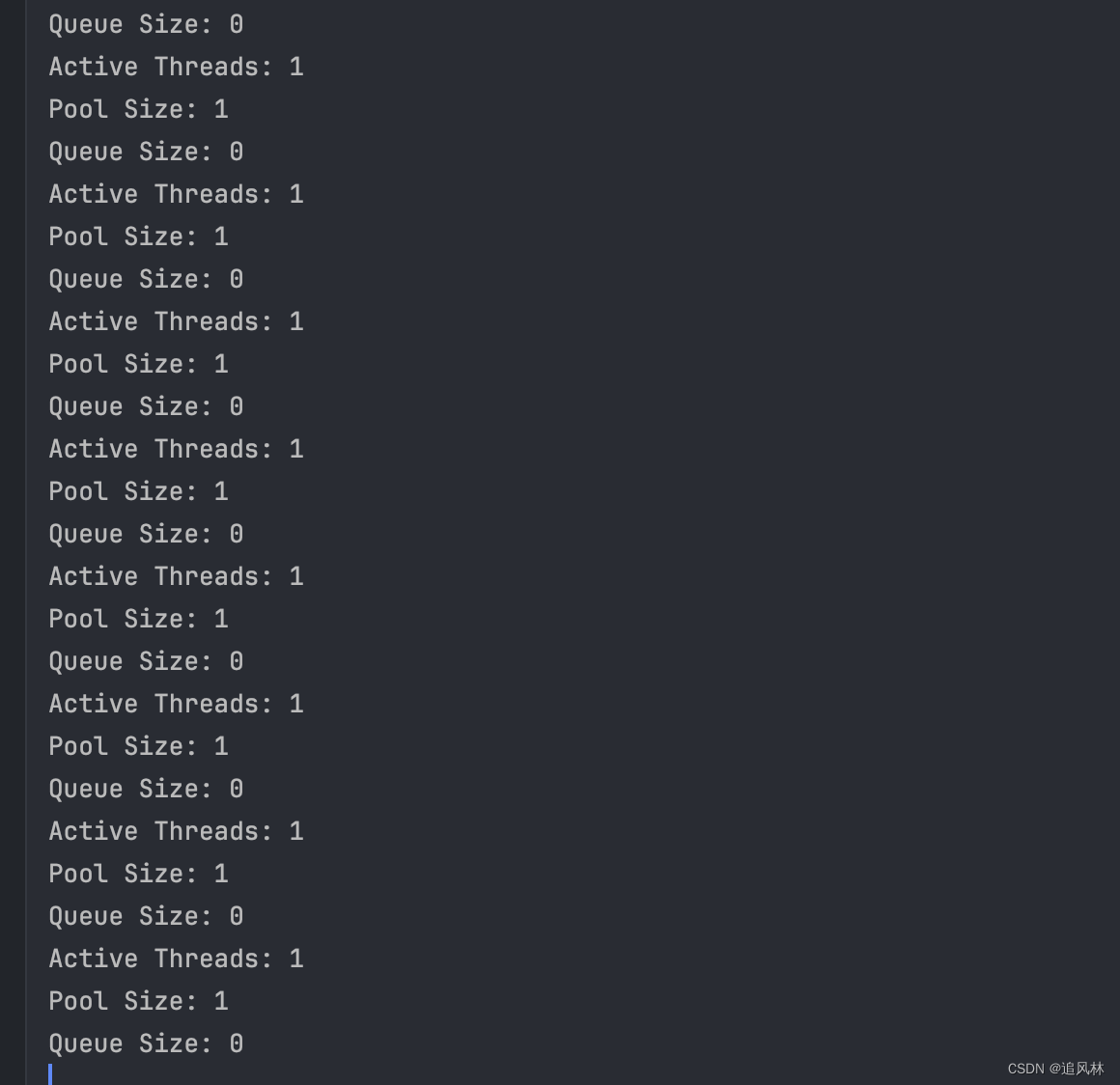核心线程数1.最大线程5.队列5.存活时间10s
1.场景一
如果核心线程数.被一直占用得不到释放.新进来1个任务.会怎么样?
答: 会在队列中中死等. 只要进来的任务.不超过队列的长度,就会一直挡在队列中死等
package com.lin;
import java.util.concurrent.Executors;
import java.util.concurrent.ThreadPoolExecutor;
import java.util.concurrent.TimeUnit;
import java.util.concurrent.LinkedBlockingQueue;
/**
* @author lin
*/
public class ThreadPoolExample {
public static void main(String[] args) {
// 创建线程池
ThreadPoolExecutor threadPoolExecutor = new ThreadPoolExecutor(
1, // 核心线程数
5, // 最大线程数
1, // 空闲线程存活时间
TimeUnit.MINUTES, // 存活时间的单位
new LinkedBlockingQueue<Runnable>(6) // 任务队列
);
// 提交第一个永不释放的任务给线程池
threadPoolExecutor.execute(() -> {
try {
System.out.println("Task 1 is running and will never complete");
while (true) {
// 模拟一个永不释放的任务
Thread.sleep(1000);
}
} catch (InterruptedException e) {
System.out.println("Task 1 was interrupted");
Thread.currentThread().interrupt();
}
});
// 等待一段时间然后提交第二个任务
try {
System.out.println("等待2秒");
Thread.sleep(2000); // 等待2秒,确保第一个任务已开始执行
} catch (InterruptedException e) {
e.printStackTrace();
}
for (int i = 0; i < 6; i++) { //模拟任务数量
int finalI = i;
threadPoolExecutor.execute(() -> {
try {
System.out.println("Task "+ finalI +"is running");
Thread.sleep(1000); // 模拟任务运行
System.out.println("Task "+ finalI +"is completed");
} catch (InterruptedException e) {
e.printStackTrace();
}
});
}
// 打印线程池状态
new Thread(() -> {
while (true) {
try {
System.out.println("Active Threads: " + threadPoolExecutor.getActiveCount());
System.out.println("Pool Size: " + threadPoolExecutor.getPoolSize());
System.out.println("Queue Size: " + threadPoolExecutor.getQueue().size());
Thread.sleep(5000); // 每5秒打印一次线程池状态
} catch (InterruptedException e) {
Thread.currentThread().interrupt();
break;
}
}
}).start();
// 等待足够的时间观察线程池状态
//try {
// Thread.sleep(60000); // 主线程等待60秒
//} catch (InterruptedException e) {
// e.printStackTrace();
//}
//
关闭线程池
//threadPoolExecutor.shutdownNow();
//try {
// // 等待所有任务完成
// if (!threadPoolExecutor.awaitTermination(60, TimeUnit.SECONDS)) {
// threadPoolExecutor.shutdownNow();
// }
//} catch (InterruptedException e) {
// threadPoolExecutor.shutdownNow();
//}
}
}

2.场景二
如果核心线程数,一直被占用.来了6个任务.效果会怎么样
答: 这是任务总数超过了队列的长度.线程池会创建新的线程来处理这个任务.根据队列的不同.消费任务的顺序不一样.以LinkedBlockingQueue.1,2,3,4,5添加到队列中.第6个任务来了.会创建线程先消费. 然后再又这个线程来处理1,2,3,4,5来处理.
然后处理完.空闲线程等待存活时间.然后被回收.线程池恢复到最开始的时候.


3.场景三
如果核心线程数和最大线程数的其他线程同时空置了,最大线程数的其他线程还没有被回收.现在队列中的任务,会被那个消费
答: 会优先被核心线程先消费